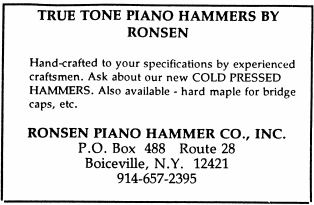Page 2
|
Tech
Tip
When we encounter a particularly unstable piano, with great pitch
deviation from season to season, a humidity control system must be
considered as one possible solution. For the installation of the
dehumidification heat rods in grand pianos there are suggested
configurations available directly from Dampp-Chaser, as well as our
own preferred arrangements gained from experience. I have found that
by "triangulating" the heating elements under the soundboard, I have
successfully stabilized even some of my customers' most difficult
instruments. I try to install 3 48 inch-50 watt rods whenever
possible --- one behind the belly rail (usually above the lyre), one
diagonally (directly beneath the long bridge), and a third one
attached to the long beam which runs parallel to the straight (bass)
side of the case. Of course, some pianos have unusual beam patterns
and some adaptations must sometimes be made (such as a shorter rod
of lesser wattage), but in general I have found that by placing the
heat rods in this triangular configuration, the greatest area of the
soundboard can be effectively dehumidified, and the most stability
achieved.
by Michael Slavin, Chapter President |

|